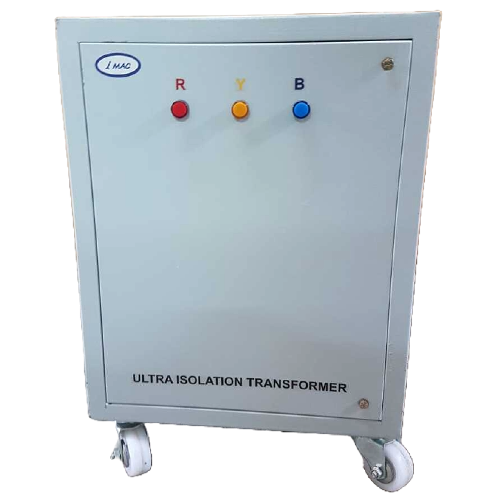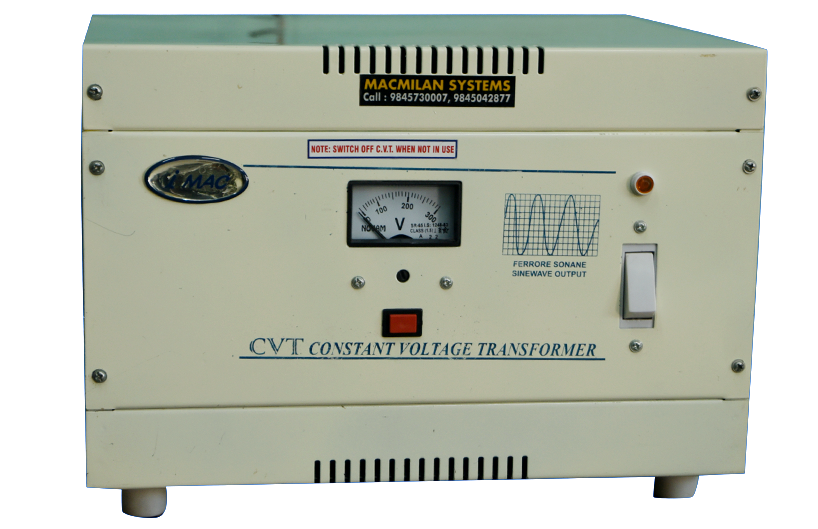
ISOLATION TRANSFORMER
An isolation transformer is a type of transformer for transferring electrical power from one circuit to another without any direct electrical connection between them. This can be incredibly useful when electrical isolation is required, such as in medical equipment, electronic devices, and industrial settings. The aim of isolation is to separate a circuit or apparatus (such as a motor, etc.) from the remainder of a system which is energized, in order that personnel may carry out work on the isolated part in perfect safety.
An isolation transformer provides the physical and electrical separation between two circuits. It isolates and protects electronic circuits and people from mainline electrical shock. Magnetic coupling is used to transfer electrical energy from primary to secondary.
Some of the benefits of dry isolation transformers are:
- Changes voltages to match the load needs
- Protects electrical appliances by reducing power surges
- Blocks interference from ground loops
- Reduces noise
- Reduces earth leakage in wet locations
- Provides stable performance
- Low energy consumption
- High working efficiency
- Prevents electronic devices from polluting the power grid
Causes of Electrical Noises in Isolation Transformers
- Changing electrical components such as capacitors, MCCBs, ACBs, etc. The magnitude of electrical sounds increases with system inductance and current shift during switching.
- Significant switching noises are also produced by inductive loads such as large motors, compressors, overhead cranes, elevators, presses, etc.
- Electrical noise is produced by switching thyristors, transistors, or relays or by switching equipment like inverters, converters, SMPS, etc.
- Anomalies in power quality are caused by welding systems, which contaminate earthing systems and alter waveforms by adding notches and high-frequency sounds.
- The natural causes of the production of diverse electrical noises include lightning, static charge precipitation, and electrical discharges in the atmosphere.
APPLICATIONS
- As pulse transformers, i.e., in computer network configuration applications
- To protect against electrical shock in electrical circuits as electric lines
- To eliminate electrical noise in electrical and electronic circuits and a very small number of sensitive equipment
- To prevent ground-level loop interference in a circuit
- To supply electricity to sensitive electronics, including computers, oscilloscopes, and medical equipment
- To assist the function of electronic testing equipment, radars, levels, and communication circuits
- To avoid damage to electrical Equipmentby spikes, etc., on computers, CNC machines, and telecommunication equipment
- To protect many electronic devices from each other's electrical noise at a common busbar, such as CNC machines, drives, hardening devices, etc
- To avoid damage from internal noise interference due to NCTs’ ability to operate in both directions
- To safeguard against powerful lightning, impulse noise, bus short-circuits, and unintentional capacitor discharge
Ultra Isolation Transformer
The ultra isolation transformer has a unique structure that eliminates all sorts of electrical noise, primarily common mode noise. Since it neutrally divides the ground on the secondary side and isolates the primary and secondary, it can be utilized to construct a separately derived source to counteract current loops. Transverse mode noise is reduced, and common mode noise is attenuated using high isolating materials and specialized shielding techniques.
Ultra isolation transformers are especially made for sensitive, important equipment like computers and peripherals, medical equipment, digital communication telemetry systems, CNC machines, and others. They prevent disruptions caused by noisy equipment loads injected into the power line. A high voltage between the windings, often in the 1000-volt to 4000-volt range, is tested, specified, and labeled for ultra isolation transformers, which are manufactured with specific insulation between the primary and secondary.

Constant Voltage Transformer
A ferroresonant technology known as a constant voltage transformer (CVT) is a 1:1 transformer that is excitingly high on its saturation curves, delivering an output voltage that is not appreciably impacted by changes in input voltage. The constant voltage transformer, or CVT, converts a fluctuating input into a nearly constant average output using a tank circuit made up of a high-voltage resonant winding and a capacitor. Typically, the input winding operates at relatively low flux linkage values.
The output winding has built-in energy storage that works with the main capacitor to create a self-generated AC flux field that is subtly removed from the input winding. Due to the absence of relays, which might cause output voltage interruption for a brief period, CVT is chosen over conventional stabilizers. With a controlled output voltage, CVT completely protects against spikes.
Ultra isolation transformers are especially made for sensitive, important equipment like computers and peripherals, medical equipment, digital communication telemetry systems, CNC machines, and others. They prevent disruptions caused by noisy equipment loads injected into the power line. A high voltage between the windings, often in the 1000-volt to 4000-volt range, is tested, specified, and labeled for ultra isolation transformers, which are manufactured with specific insulation between the primary and secondary.

The different types of isolation transformers for each specific applications
- Single-Phase Transformers have a simple structure and small size that makes them suitable for low-voltage distribution networks with small load density, such as residential areas.
- Harmonic Mitigation Transformers are appropriate for installations with several harmonic loads, such as educational institutes, government buildings, commercial operations, medical facilities, and call centers, which require consistent operation of computers, printers, and communication equipment.
- Drive Isolation Transformers are used to isolate AC or DC motor circuits from the input voltage system and are used with industrial heating.
- K-Factor Transformers are designed to function in high harmonic loads such as computer rooms and areas with high levels of non-linear loads.
- Three-Phase Transformers are designed for power generation and electrical distribution networks. They are used for high-power industrial loads such as rectifiers and motor drives.

